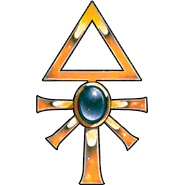No edit summary Tag: Visual edit |
No edit summary |
||
| (3 intermediate revisions by the same user not shown) | |||
| Line 1: | Line 1: | ||
| + | [[File:Eldar.png|frame|The icon of the Aeldari species]] |
||
| ⚫ | |||
| + | '''Gea''', also sometimes called '''Gia''', is one of the goddesses of the [[Aeldari]], and a member of the Aeldari pantheon, though her role within it is unknown. |
||
| + | |||
| + | Little is recorded of her in the fragments of [[Aeldari Mythology]] available to the savants of the [[Imperium of Man]], though she has claimed both [[Asuryan]] the Phoenix King, ruler of the Aeldari gods, and [[Khaela Mensha Khaine]], the Aeldari god of war, as her twin consorts. |
||
| + | |||
| ⚫ | Dance, mime and other gestural art forms are very important to the Aeldari, and their formal art invests a whole range of gestures and stances with precise meanings. Much of the early history of the Aeldari is recorded in the form of traditional dances, recounting the mythical stories of the ancient houses of [[Eldanesh]] and [[Ulthanash]], the children of [[Kurnous]] and [[Isha]], as well as Gea and her consorts. |
||
| + | |||
| ⚫ | The legends surrounding these mythical immortals and the birth of the Aeldari species form a complex cycle of ritual dance and song known as the ''Dream of Asuryan.'' Although mythic rather than historical in nature, this cycle of dance and song is said to embody profound secrets about the Aeldari past within its subtle movements and tonal variations. |
||
| + | |||
| + | In their highest form these dances are performed only by the Aeldari [[Harlequins]]. Only they really understand all of the myriad secrets hidden within these extremely physically demanding and incredibly precise movements. |
||
| ⚫ | The legends surrounding these mythical immortals and the birth of the Aeldari form a complex cycle of ritual dance and song known as the ''Dream of Asuryan'' |
||
==Sources== |
==Sources== |
||
*''Warhammer 40,000: Compilation'' (1st Edition), pg. 35 |
*''Warhammer 40,000: Compilation'' (1st Edition), pg. 35 |
||
Revision as of 18:57, 28 March 2019

The icon of the Aeldari species
Gea, also sometimes called Gia, is one of the goddesses of the Aeldari, and a member of the Aeldari pantheon, though her role within it is unknown.
Little is recorded of her in the fragments of Aeldari Mythology available to the savants of the Imperium of Man, though she has claimed both Asuryan the Phoenix King, ruler of the Aeldari gods, and Khaela Mensha Khaine, the Aeldari god of war, as her twin consorts.
Dance, mime and other gestural art forms are very important to the Aeldari, and their formal art invests a whole range of gestures and stances with precise meanings. Much of the early history of the Aeldari is recorded in the form of traditional dances, recounting the mythical stories of the ancient houses of Eldanesh and Ulthanash, the children of Kurnous and Isha, as well as Gea and her consorts.
The legends surrounding these mythical immortals and the birth of the Aeldari species form a complex cycle of ritual dance and song known as the Dream of Asuryan. Although mythic rather than historical in nature, this cycle of dance and song is said to embody profound secrets about the Aeldari past within its subtle movements and tonal variations.
In their highest form these dances are performed only by the Aeldari Harlequins. Only they really understand all of the myriad secrets hidden within these extremely physically demanding and incredibly precise movements.
Sources
- Warhammer 40,000: Compilation (1st Edition), pg. 35
- The Masque of Vyle (Novella) by Andy Chambers, pg. 74
